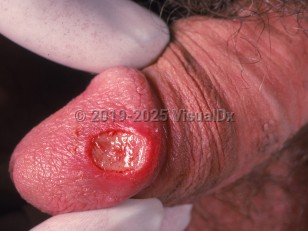Syphilis is a sexually transmitted infection (STI) caused by the spirochete bacterium Treponema pallidum. It is characterized by a chronic intermittent clinical course. Treponema pallidum is transmitted person to person via direct contact with a syphilis ulcer during vaginal, anal, or oral sex and may enter through skin or mucous membranes. Hence, the locations for syphilitic ulcers include the vagina, cervix, penis, anus, rectum, lips, hands, and inside of the mouth.
Treponema pallidum can also cross the placenta and infect an unborn child, resulting in early congenital syphilis. See also late congenital syphilis.
In the primary stage of syphilis, a painless ulceration, or chancre, typically appears about 21 days after initial infection, often preceded by a firm, painless papule.
- In girls, the genital chancre is difficult to observe because of its location in the vagina or on the cervix.
- In boys, the chancre is easily seen on the frenulum or on the coronal sulcus of the penis but may hide under the foreskin.
Chancres vary in size from a few millimeters to several centimeters. They have an incubation period of 10-90 days (average 21 days). The chancre lasts 3-6 weeks and heals spontaneously. All patients with primary syphilis will go on to develop secondary syphilis if the condition is left untreated. Secondary syphilis usually appears 3-10 weeks after the primary chancre and is characterized by a papulosquamous eruption and mucosal involvement, in some cases. Tertiary syphilis may appear months to years after secondary syphilis resolves and can involve the central nervous system (CNS), heart, bones, and skin.
Ocular screening (eg, slit lamp examination) is advised for patients with suspected or proven syphilis.
Childhood sexual abuse is a problem of epidemic proportions affecting children of all ages and economic and cultural backgrounds. There are few unambiguous diagnostic signs of sexual abuse, and they are present in only a minority of victims. They include objective evidence of characteristic genital trauma and the detection of specific STIs. The presence of semen, sperm, acid phosphatase, a positive serologic test for syphilis or HIV, and a positive culture for gonorrhea are considered absolute evidence of sexual abuse when congenital acquisition of the disease and transfusion-acquired HIV are excluded. Nonsexual transmission of syphilis from an infected parent to a child is rare, and sexual abuse should always be assumed until proven otherwise.
Related topics: ocular syphilis, endemic syphilis



 Patient Information for
Patient Information for 
